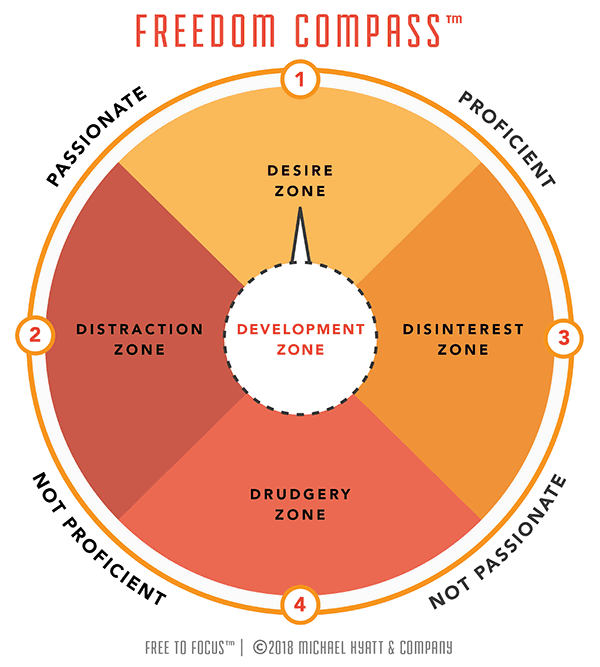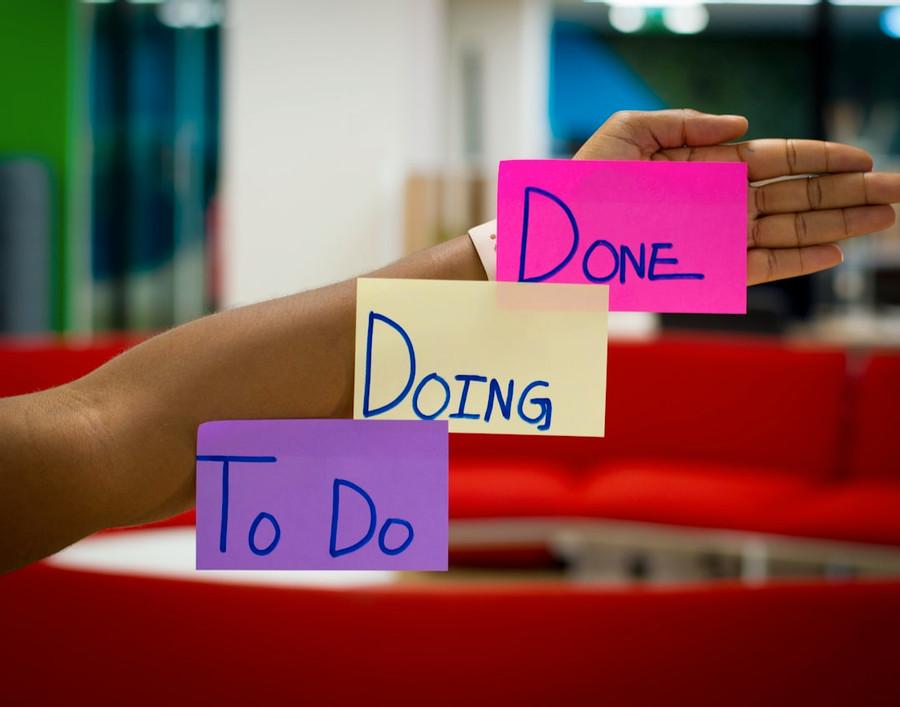Alexis T.'s Key Ideas from Free to Focus
by Michael Hyatt
Ideas, facts & insights covering these topics:
19 ideas
·30.1K reads
168
2
Explore the World's Best Ideas
Join today and uncover 100+ curated journeys from 50+ topics. Unlock access to our mobile app with extensive features.
The Premise Of The Book
In a world where information is freely available, focus becomes one of the most valuable commodities in the workplace.
Productivity is not about getting more things done; it’s about getting the right things done.
The core idea is a productivity system to help you focus on working on the right things. First, you’ll stop and define what productivity means to you by formulating, evaluating, and reformulating. Then, you’ll cut the nonessentials by eliminating, automating, and delegating. Finally, you’ll act by consolidating, designating, and activating.
301
3.81K reads
The Free to Focus productivity system: Stop
Formulate: Decide What You Want
True productivity starts with being clear on what you truly want.
The objective of productivity shouldn’t be efficiency or success, but freedom. Productivity should ultimately give you back more time, not require more of you.
Freedom to:
- Focus
- Be Present
- Be Spontaneous
- Do Nothing
You should design your life first and then tailor work to meet your lifestyle objectives.
294
3.11K reads
Free To Focus: How To Formulate
Start by defining what your productivity ideal looks like
Then break it down into a few powerful and memorable words
Finally, clarify the stakes by outlining exactly what you stand to gain if you achieve that vision and what you will lose if you don’t
268
2.91K reads
Evaluate: Determine Your Course
You can evaluate tasks, activities, and opportunities based on two key criteria:
- Passion: work you love and energizes you
- Proficiency: how well you actually do something that generates results that other people can measure and reward
To determine where you are right now use a tool called the Freedom Compass.
266
2.3K reads
The 5 Zones of Productivity
- Desire Zone. Where your passion and proficiency intersect. Here is where you make your most significant contributions.
- Distraction Zone. Things you are passionate about but have little proficiency for.
- Disinterest Zone. Things that you’re proficient at but aren’t that passionate about.
- Drudgery Zone. Tasks for which you have no passion and no proficiency.
- Development Zone. How to gauge work outside your Desire Zone but potentially moving toward it.
True productivity is about doing more of what is in your Desire Zone and less of everything else.
310
2.12K reads
Rejuvenate: Reenergize Your Mind and Body
- Sleep. 7-10 hours per night. Turn off screens an hour before bedtime.
- Eat. Eat natural foods such as vegetables, fruits, nuts, and meats. Be mindful when eating out.
- Move. Exercise itself is an energizer. Physical activity primes our brains to operate at a higher level.
- Connect. Some people charge you up while others drain you.
- Play. You need regular injections of recreation, exercise, and outright play into your busy schedule.
- Reflect. Strive to make time for reflection every day by journaling or meditating.
- Unplug. Create rules to help you disconnect during nights, weekends, and vacations.
301
1.71K reads
Cut: Eliminate To Flex Your “No” Muscle
If we want to be free to focus, we must eliminate everything standing in our way. That doesn’t mean simply saying no to a lot of bad ideas; it also means turning down a ton of good ideas.
Everything outside your Desire Zone is a possible candidate for elimination.
The yes-no-yes strategy to give a “positive no”:
- Yes. Say yes to yourself and protect what is important to you.
- No. The answer continues with a matter-of-fact no that is clear and sets boundaries. No wiggle room or ambiguity.
- Yes. End the response by affirming the relationship again and by offering another solution.
267
1.56K reads
The Not-To-Do List: Renegotiate Existing Commitments
- Take responsibility for making the commitment
- Reaffirm your willingness to honour your commitment
- Explain why honouring your commitment is not the best outcome for the other party
- Offer to help solve the problem with them
How to create a Not-To-Do List:
- Start with the obvious candidates for elimination
- List the meetings, relationships, and opportunities you should never pursue
261
1.48K reads
Automate: Subtract Yourself from the Equation
- Self. Use rituals to make it easier for you to follow through on your highest priorities. The 4 Foundational Rituals: morning, evening, workday startup, and workday shutdown.
- Template. Automate repetitive tasks with templates.
- Process. Write an easy-to-follow set of instructions for performing a job or sequence.
- Tech. Focus on the type of tool you need more than which tool you use. The 4 essential tools: email filtering, macro-processing, text-expansion, and screencast
- To streamline your tasks, mark candidates for automation and pick one to tackle today.
267
1.22K reads
Delegate: Clone Yourself—or Better
Delegation means focusing primarily on the work only you can do by transferring everything else to others who are more passionate about the work or proficient in the tasks.
Some of us refuse to delegate by convincing ourselves we can’t afford it.
But the hours you spend on Desire Zone tasks will always be more profitable than the time you’re wasting anywhere else, so the cost of delegation pays for itself—and then some.
256
1.1K reads
How to delegate:
- Decide what to delegate.
- Select the best person.
- Communicate the workflow.
- Provide the necessary resources.
- Specify the delegation-level
- Give them room to operate.
- Check in and provide feedback as needed.
263
1.29K reads
The 5 Levels of Delegation
- Level 1. You want the person to do exactly what you’ve asked them to do—no more, no less.
- Level 2. You want the person to examine or research a topic and report back to you.
- Level 3. You’re giving the person more room to participate in the problem-solving process but you are still reserving the final decision for yourself.
- Level 4. You want the person to evaluate the options, make a decision on their own, execute the decision, and then give you an update after the fact.
- Level 5. You hand the entire project or task over to someone else and exit the decision altogether.
275
940 reads
Act: Consolidate and Plan Your Ideal Week
Design your work to focus on just one thing at a time.
- Batching: lumping similar tasks together and doing them in a dedicated block of time
- MegaBatching: organizing entire days around similar activities to enable you to stay focused and build momentum.
264
1.08K reads
The 3 Categories Of Activity
- Front Stage. The tasks for which you’re hired and paid. The key functions, primary deliverables, the line items on your performance review. If it delivers the results for which your boss and/or customers are paying you, that’s Front Stage work.
- Back Stage. Includes elimination, automation, and delegation plus coordination, preparation, maintenance, and development. The tasks necessary for Front Stage performance.
- Off Stage. Refers to time when you’re not working. Off Stage is crucial to restoring your energy so you have something to offer when you come back to the stage.
263
909 reads
How to Plan Your Ideal Week in 3 Steps
- Stages. Decide for each day if you’ll be Front Stage, Back Stage, or Off Stage. Reserve at least two days for Front Stage.
- Themes. Indicate what type of activities you’ll do on individual days during certain blocks of time. An easy way to start is to think of the morning, workday, and evening.
- Activities. Group the individual activities that will fall into those themes.
259
952 reads
Designate: Prioritize Your Tasks
You need to systematically decide what deserves your attention now, what deserves your attention later, and what doesn’t deserve your attention at all.
How to do a weekly review:
- List Your Biggest Wins
- Review the Prior Week
- Review Your Lists and Notes
- Check Goals, Projects, Events, Meetings, and Deadlines
- Designate Your Weekly Big 3 Things to Accomplish
- Plan Your Rejuvenation
259
882 reads
The Eisenhower Matrix
Spend 95% of your time on Quadrant 1 and 2 activities. Clear Quadrant 3 tasks quickly (delegate what you can) and eliminate all Quadrant 4 tasks.
How to design your day:
Plan days solely focused on tasks and refuse any meeting requests for that day
Shoot for three, and only three, key tasks each day (your Daily Big 3). Let your Weekly Big 3 inform your Daily Big 3.
Schedule time to do your Daily Big 3 on your calendar
268
943 reads
Activate: Beat Interruptions
- Limit instant communication. Turn off your notifications and opt for delayed communication whenever possible.
- Proactively set and enforce boundaries. Inform the relevant people you’re going offline for a period to focus on by setting an autoresponder for your email. Sell your boss why you need time for deep, focused work.
249
863 reads
How to beat distractions:
- Fight technology with technology. Example: _Freedom _lets you customize what apps and websites you can access during dedicated periods of deep work.
- Listen to the right music. Background music that’s familiar, repetitive, relatively simple, and not too loud can aid focus.
- Take charge of your environment. Make your workspace work for you. Optimize your current workspace for focus by eliminating distracting items.
- Declutter your workspace. Make an appointment with yourself on your calendar to organize your office.
- Increase your frustration tolerance. Train yourself to focus with hard tasks.
253
917 reads
IDEAS CURATED BY
"Making money is art and working is art and good business is the best art." ~ Andy Warhol
CURATOR'S NOTE
True productivity is about doing more of what is in your desire zone and less of everything else.
“
Alexis T.'s ideas are part of this journey:
Learn more about books with this collection
How to create a productive workspace at home
How to balance work and personal life while working remotely
How to maintain focus and motivation while working remotely
Related collections
Discover Key Ideas from Books on Similar Topics
3 ideas
11 ideas
12 Time Management Mistakes That Set You Up for Failure
entrepreneur.com
5 ideas
5 Self-Care Tips For Staying Sane While Juggling A Demanding Career
thoughtcatalog.com
Read & Learn
20x Faster
without
deepstash
with
deepstash
with
deepstash
Personalized microlearning
—
100+ Learning Journeys
—
Access to 200,000+ ideas
—
Access to the mobile app
—
Unlimited idea saving
—
—
Unlimited history
—
—
Unlimited listening to ideas
—
—
Downloading & offline access
—
—
Supercharge your mind with one idea per day
Enter your email and spend 1 minute every day to learn something new.
I agree to receive email updates















